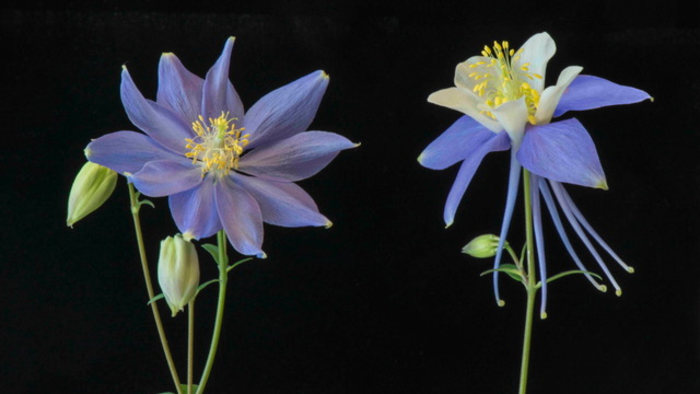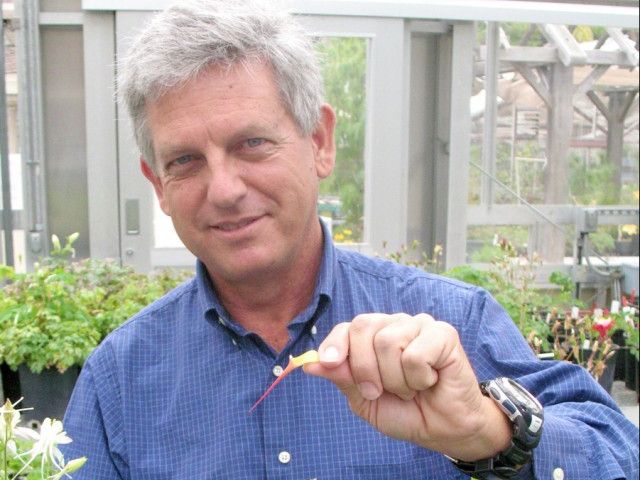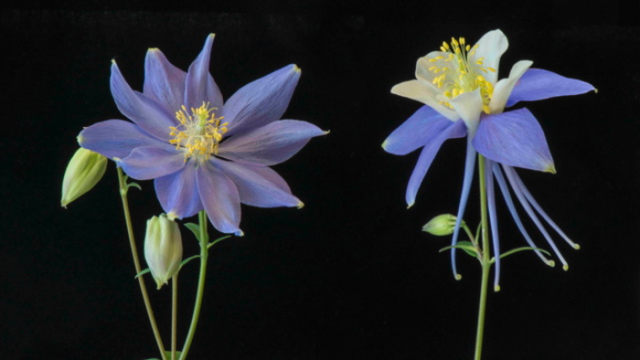
Evolution can occur in great leaps, despite Charles Darwin’s theory of evolution by natural selection and small changes over time. Scientists have identified a flower in Colorado dubbed a “hopeful monster,” mutating to adapt to its environment.
“Evolution doesn’t necessarily take all these small changes like Darwin proposed,” Scott Hodges of the University of California-Santa Barbara said of the theory.
Hodges and Zachary Cabin, affiliated with the same university, identified rapid evolutionary change in Colorado blue columbines (Aquilegia coerulea) and a naturally occurring variant, A. coerulea daileyae. The latter lacks the nectar spurs of the former, replacing them with petal-like sepals due to a mutation in a single gene. The two scientists are part of a team that published a study on these findings in the journal Current Biology.
Scientists have long argued over whether evolution plods along for millennia or if it sees sudden, abrupt changes. Large changes in the shape or morphology of species appear in the fossil record within short geological timescales, while intermediate changes may not show up. Researchers have tried to observe the change as it happens to show that sudden developments may drive evolution.
In the study, researchers found a population of Colorado blue columbines was losing petals that feature characteristic nectar spurs. This genetic mutation is not unusual for the species, but spurlessness appears to have become a feature of the area under study: about 25 percent of the plants lack spurs.

The team found that just one gene, APETALA3-3, controls the flower’s spurs and nectaries. “The gene is either on or off, so it’s about as simple of a change [as] you can get,” said Cabin. “But that simple difference causes a radical change in morphology,” he said of the broken gene that causes the loss of petals or nectar spurs.
If these had been fossil specimens, they might have been classified as distinct genera. No intermediate form of the plants would have shown up in the fossil record to show a transition from one to the other. “This finding shows that evolution can occur in a big jump if the right kind of gene is involved,” Hodges said.
APETALA3-3 is a homeotic gene that programs how an organ develops, which can be drastically affected by a mutation. “Most of the mutations of this nature are going to be like that — just awful,” Hodges said, adding that such organisms cannot survive. “Biologist Richard Goldschmidt called them ‘hopeless monsters,’” he said.

Because APETALA3-3 programs an organ to become a petal, “when it’s broken, those instructions aren’t there anymore, and that causes it to develop into a completely different organ — a sepal,” Hodges said.
One of these giant leaps may sometimes yield a trait that is adaptive to a particular environment. This may mean that evolution moves forward in single, large jumps, supportings the punctuated equilibrium hypothesis.
“We did not have a good example of a hopeful monster due to a single genetic change until now,” said Hodges. Other relatives of columbines have also lost petals and nectaries, but scientists had not determined whether the change was gradual or in a giant leap. Because Hodges and Cabin observed this actively happening in a patch of Colorado blue columbines, they can confirm that the bloom is a hopeful monster.
The researchers concluded that the mutation was not mere chance. “To get that many of this mutant type really suggests that there’s selection favoring it somehow,” Hodges said.
He finds it odd because spurs produce nectar and attracts pollinators. But attracting pollinators is only one factor in reproduction. The mutant columbine actually produced more seeds than its counterparts. After checking their data, the authors saw a pattern emerge.
The researchers observed that aphids, caterpillars and deer eat the various versions or morphs of the columbine. While aphids and caterpillars can limit seed production, deer eat and tear up the entire plant. Further data showed that aphids and deer prefer to munch on flowers with nectar spurs.

Change in the morphology of these flowers is usually driven by pollinators, such as hawk moths and bumblebees, but spurlessness appears to be an adaptation to animals consuming the plants. Producing the spurs and nectaries takes a significant amount of energy, according to the study, that can be used instead for producing seeds.
Having identified their hopeful monster, the authors hope to develop a timeline of when the mutations may have occurred and determine how spurlessness is spreading among the flowers.
The Colorado blue columbine may be diverging into separate species, especially since the two types seem to rely on different pollinators. “That splitting process would be slow,” Cabin said, “but there is evidence that it could be on its way.”
“Natural selection can come from very surprising sources. It’s not always what you’d expect it to be,” Hodges said.
Edited by Siân Speakman and Kristen Butler
Recommended from our partners
The post Natural Selection Isn’t Always Slow, Flower Study Finds appeared first on Zenger News.




